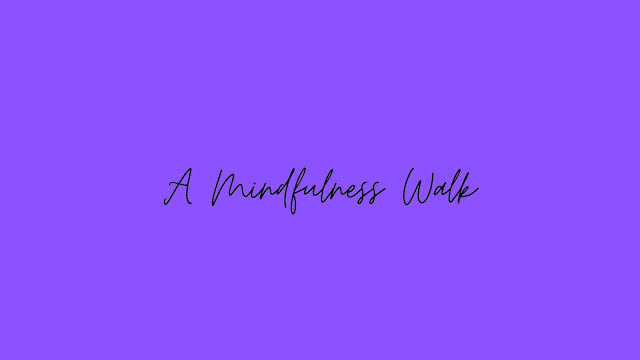A mindfulness walk
Two years ago we visited Rufford Old Hall whilst on holiday in Lancashire. I spotted they had a Mindfulness Walk leaflet at the entrance and when NAH said he needed his post lunch nap, I decided to try it. I found it most calming and since then I've adapted it for my own garden.
I've found it a useful way to start the day, even when it's raining and seeing today is World Mental Health Day, I thought you might like to see it too. Note, I'm not a mental health expert, nor a trained practitioner in any way, but if the following helps just one person, then I'm happy it's done some good.
I've deliberately created some cards rather than using photos of my own garden to help make it suitable for any time of the year and I hope that'll make it easier for you to adapt too. Feel free to choose a different order to the one shown for your own circumstances, and/or omit any steps that don't 'speak' to you, though I recommend doing the Breathe part as a minimum as this is such a good (and relatively quick) way of calming down. I also find this is particularly useful after spending lots of time at the computer - I've spotted I tend to hold my breath a lot when I'm at the keyboard, which in turn can make me quite tense. I've deliberately chosen purple for my cards because it's a calming colour.
What if you don't have a garden? Follow the guided steps below in a place you like outside e.g. your local park. Alternatively you could omit the Walk element (and any other steps which don't apply) and complete the rest from your home's balcony, window or doorway. The idea is to find the place and activities which calm your mind and help you live in the moment.
Now come with me for a step by step guide to the walk...
For this element I start by opening our kitchen door and step out onto the patio. Then I stand tall and place my feet hip width apart just like I would for choir or pilates and just focus on how my feet are connected with the ground. Then I close my eyes and focus on my breath, making sure I breath deeply and from down in my abdomen, rather than up in my chest. If this feels uncomfortable, then I breathe in through my nose for a count of five and then out through my lips for the same count. The sound made when I breathe out helps me to calm down, as does being outside.
Once my breathing has calmed down, I pay attention to what I can hear from my surroundings. It's an acknowledgement rather than naming what I can hear, because the latter doesn't help my mind calm down. If I start trying to identify the birds I can hear - for instance - I return to the breathing exercise again. In a lot of ways I find listening and breathing are connected together instead of being the separate steps outlined here. I usually have my eyes closed for this part, but then I need to open my eyes ready to...
We incorporated a walk into our garden's design and this usually determines the route I take around the garden. For some reason I usually go the same way; I really must go the other way some time and note the differences in how I feel and what I notice.
This is a slow walk where I notice how each step feels as I take it, plus the sound of the crunchy gravel on the path and how this contrasts with the steps to/from the patio.
Then I stop and have a good look around to let the scene fill my eyes...
... the danger with this step is your mind starts making a list of what needs doing, or you forget the walk and get cracking on some gardening. Resist, my friends, resist! If this happens I just acknowledge the thought, take a deep breath or two (sometimes with my eyes closed as well) and return to the moment.
If this doesn't work for you and your mind's still awhirl, then close your eyes and think of a colour. Then take a look around and find which elements of the garden have that colour; acknowledge each one in turn with a deep breath; notice the subtle differences between items with the same colour and then move on.
Another approach is to choose an object such as a leaf and look at it really closely and savour its detail as if you've not seen it before. Alternatively you could notice any changes since your last walk - what's come into flower today; what are the leaves doing; are there signs of any garden visitors e.g. birds (or pesky squirrels in my case); what's the weather doing today and are there any signs it might change?
I must admit this step often gets omitted in my garden as I have so few strokeable plants. I'm in the process of adding some grasses to the Stachys I have already to boost this aspect of my walk. Of course, it doesn't have to be strokeable, it could be any element that has some texture e.g. knobbly bark, the warmth of a wooden bench in the sunshine, cool grass on bare feet on a summer's day, or one of our cats. Close your eyes in a safe space and let your fingers do the walking. Focus on the object at hand and really feel it - is it soft or hard; smooth or rough in texture; big or small in relation to your hand; dry,damp or wet (I find dry's usually best for staying in the moment 😉) etc.
This is another aspect of the garden which I often overlook and in this instance we're talking edible items only - which you may or may not have in your own garden. It's much easier for me to incorporate this step when there are tiny thimbles of alpine strawberries or some cherry tomatoes to sniff and savour on the patio. I've added to the range of herbs by our back door this year, so I can pick a couple of leaves to nibble. In the summer this often means picking some of my prolific lemon balm a) to keep it in check (once you have lemon balm, it's with you forever) and b) to make it into a refreshing tea on my return indoors.
If you do find something to taste, sniff it as well as the two senses are closely linked. In this instance I try to find pleasant things to sample, otherwise the calming effect gets lost! With your chosen item, is it sweet, bitter or something else? Is the taste strong or almost not there (it might change with time e.g. as a fruit ripens), and does it linger afterwards? How does it make you feel?
Then when I've returned to where I started, I close my eyes and finish the walk with a couple of deep breaths before opening them again and heading back indoors.
Finally, here's a summary of the walk so you can focus each element for yourself without the accompanying explanations of each step. I find the walk takes me between 5 to 10 minutes in my small urban garden, a good injection of calm into a busy life!
My anecdotal findings are backed up academically too. A study by Kaplan showed that spending 10 minutes in a natural environment helps to reduce stress and restores the ability to concentrate compared to being in a car park. If you're working from home these days that sounds like the perfect excuse to step out into your garden and just be for a while 🙂
If anyone is feeling particularly anxious, then the 5-4-3-2-1 coping technique could prove a useful guided addition to the steps I've outlined.
Note that the walk at Rufford Old Hall was adapted from The Little Book of Mindfulness by Patrizia Collard. Their walk had just four steps: Listen, Breathe, Walk and Look which took visitors to their South Lawn, Beech Walk Paddock, Lover's Walk near the vegetable patch, then back to the South Lawn. It was a good way of getting visitors to see most of the garden!
What technique(s) do you use to help de-stress and calm down? We're all different, so a variety of suggestions are welcome to help us all during these strange times.



















That is a good practice, mindfulness for gardeners. We try and remember to follow a 5 minute Breathworks UK vimeo video by Vidyamala Burch.
ReplyDeleteOoh that sound good - I'll investigate, thanks :)
Delete